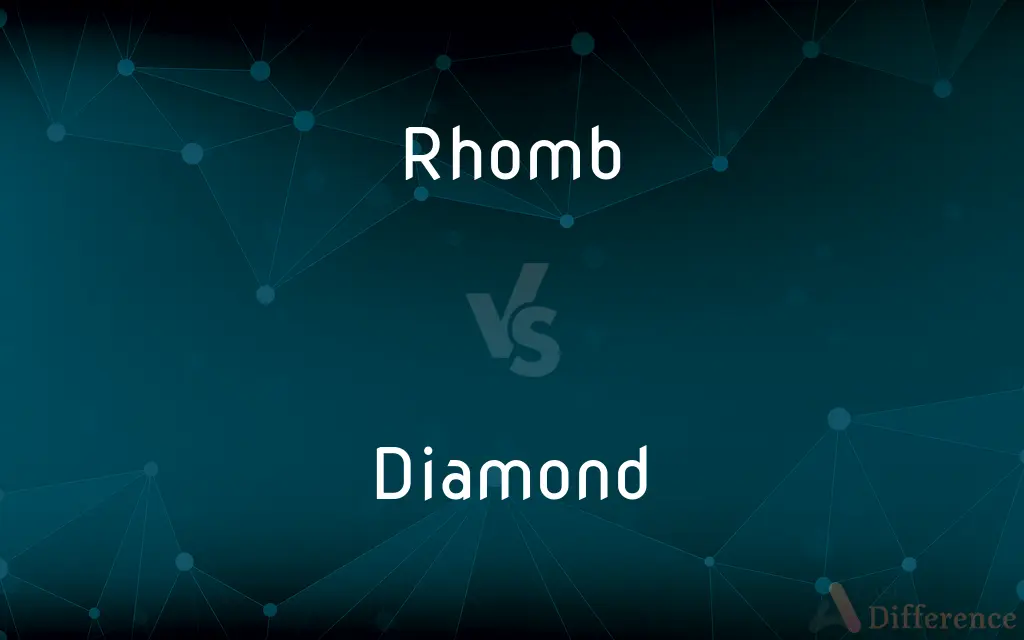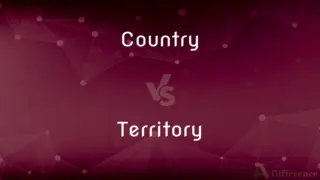Rhomb vs. Diamond — What's the Difference?
By Fiza Rafique & Urooj Arif — Updated on April 8, 2024
A rhomb (or rhombus) is a geometric figure with four equal sides and opposite equal angles, while a diamond is a gemstone or a shape inspired by its cut.

Difference Between Rhomb and Diamond
Table of Contents
ADVERTISEMENT
Key Differences
A rhomb, also known as a rhombus, is a type of quadrilateral in geometry, characterized by four equal-length sides, with opposite sides being parallel and opposite angles being equal. On the other hand, a diamond refers to a precious gemstone known for its brilliance and hardness or a shape that resembles the gemstone's typical cut, often used in various designs and symbols.
In mathematics, the properties of a rhomb are strictly defined by Euclidean geometry, focusing on its sides, angles, and symmetry. A diamond, as a shape, loosely adopts this geometric form but is more commonly associated with its visual representation in jewelry, art, and symbolism, where the emphasis is on aesthetics rather than precise geometrical properties.
The term "rhomb" is used exclusively within mathematical and geometrical contexts to describe a specific polygon, emphasizing its structural properties. Conversely, "diamond" is used in a broader sense, spanning from gemology to representational shapes in playing cards, signage, and decorative elements, highlighting its cultural and aesthetic significance.
While the geometric principles underlying the shape of a rhomb are constant and universally applicable, the appearance and qualities of a diamond (gemstone) can vary widely based on cut, color, clarity, and carat weight. This distinction illustrates the difference between a mathematical concept and a physical or visual entity that carries additional subjective value.
In education, students are taught about the rhomb as part of their geometry curriculum, learning to appreciate its mathematical properties and significance. Meanwhile, diamonds are often discussed in the context of earth science, gemology, and economics, focusing on their formation, valuation, and role in human society.
ADVERTISEMENT
Comparison Chart
Definition
A quadrilateral with all sides of equal length and opposite equal angles.
A gemstone or a shape inspired by the gemstone's cut.
Context
Geometry
Gemology, jewelry, and symbolism
Properties
Four equal sides, opposite sides parallel, opposite angles equal.
Valued for its optical properties and hardness; shape varies in interpretation.
Significance
Mathematical importance in geometry.
Cultural, aesthetic, and economic value.
Variation
Geometrically constant; variations are not applicable.
Physical characteristics (cut, color, clarity, carat) affect its appearance and value.
Compare with Definitions
Rhomb
A four-sided polygon with all sides of equal length.
In geometry, a square is a special case of a rhomb with all right angles.
Diamond
A shape inspired by the typical cut of a diamond gemstone.
The diamond shape is popular in jewelry design and playing cards.
Rhomb
A symbol of symmetry and balance in geometry.
The rhomb is used to teach concepts of symmetry to students.
Diamond
Varied in quality by the 4Cs: cut, color, clarity, and carat.
The value of a diamond is assessed based on the 4Cs.
Rhomb
Characterized by opposite sides being parallel and angles being equal.
The children's kite, shaped like a rhomb, flew high in the sky.
Diamond
A precious gemstone known for its hardness and brilliance.
The ring featured a diamond known for its exceptional clarity.
Rhomb
A geometric figure important in Euclidean geometry.
Drawing a rhomb involves ensuring all sides are of equal length.
Diamond
Symbolizes wealth, luxury, and durability.
Diamonds are often gifted as a symbol of eternal love and commitment.
Rhomb
Not to be confused with similar quadrilaterals; specificity is key.
Although similar to a rectangle, a rhomb has all sides equal, not just opposite sides.
Diamond
Used metaphorically to denote something precious and enduring.
His diamond-like determination was admired by all.
Rhomb
See rhombus.
Diamond
Diamond is a form of the element carbon with its atoms arranged in a crystal structure called diamond cubic. At room temperature and pressure, another solid form of carbon known as graphite is the chemically stable form of carbon, but diamond almost never converts to it.
Rhomb
A rhombohedral crystal.
Diamond
A precious stone consisting of a clear and colourless crystalline form of pure carbon, the hardest naturally occurring substance
A diamond ring
Rhomb
A rhombus.
Diamond
A figure with four straight sides of equal length forming two opposite acute angles and two opposite obtuse angles; a rhombus
A sweater with a pale-blue diamond pattern
Rhomb
A rhombohedron.
Diamond
An extremely hard, highly refractive crystalline form of carbon that is usually colorless and is used as a gemstone and in abrasives, cutting tools, and other applications.
Rhomb
An equilateral parallelogram, or quadrilateral figure whose sides are equal and the opposite sides parallel. The angles may be unequal, two being obtuse and two acute, as in the cut, or the angles may be equal, in which case it is usually called a square.
Diamond
A piece of jewelry containing such a gemstone.
Rhomb
A rhombohedron.
Diamond
A rhombus, particularly when oriented so that one diagonal extends from left to right and the other diagonal extends from top to bottom.
Rhomb
A parallelogram with four equal sides; an oblique-angled equilateral parallelogram
Diamond
A red, lozenge-shaped figure on certain playing cards.
Diamond
A playing card with this figure.
Diamond
Diamonds (used with a sing. or pl. verb) The suit of cards represented by this figure.
Diamond
The infield.
Diamond
The whole playing field.
Diamond
Of or relating to a 60th or 75th anniversary.
Diamond
To adorn with diamonds.
Diamond
(uncountable) A glimmering glass-like mineral that is an allotrope of carbon in which each atom is surrounded by four others in the form of a tetrahedron. Category:en:Carbon
The saw is coated with diamond.
Diamond
A gemstone made from this mineral.
The dozen loose diamonds sparkled in the light.
Diamond
A ring containing a diamond.
What a beautiful engagement diamond.
Diamond
A very pale blue color.
Diamond
Something that resembles a diamond.
Diamond
(geometry) A rhombus, especially when oriented so that its longer axis is vertical.
Diamond
(geometry) The polyiamond made up of two triangles.
Diamond
(baseball) The entire field of play used in the game.
Diamond
(baseball) The infield of a baseball field.
The teams met on the diamond.
Diamond
(card games) A card of the diamonds suit.
I have only one diamond in my hand.
Diamond
A size of type, standardised as 2 point.
Diamond
The size of type between brilliant and pearl, standardized as 2-point.
Diamond
Made of, or containing diamond, a diamond or diamonds.
He gave her diamond earrings.
Diamond
Of, relating to, or being a sixtieth anniversary.
Today is their diamond wedding anniversary.
Diamond
Of, relating to, or being a seventy-fifth anniversary.
Today is their diamond wedding anniversary.
Diamond
(slang) First-rate; excellent.
He's a diamond geezer.
Diamond
To adorn with or as if with diamonds
Diamond
A precious stone or gem excelling in brilliancy and beautiful play of prismatic colors, and remarkable for extreme hardness.
Diamond
A geometrical figure, consisting of four equal straight lines, and having two of the interior angles acute and two obtuse; a rhombus; a lozenge.
Diamond
One of a suit of playing cards, stamped with the figure of a diamond.
Diamond
A pointed projection, like a four-sided pyramid, used for ornament in lines or groups.
Diamond
The infield; the square space, 90 feet on a side, having the bases at its angles.
Diamond
The smallest kind of type in English printing, except that called brilliant, which is seldom seen.
Diamond
Resembling a diamond; made of, or abounding in, diamonds; as, a diamond chain; a diamond field.
Diamond
A transparent piece of diamond that has been cut and polished and is valued as a precious gem
Diamond
Very hard native crystalline carbon valued as a gem
Diamond
A playing card in the minor suit of diamonds
Diamond
The area of a baseball field that is enclosed by 3 bases and home plate
Diamond
The baseball playing field
Common Curiosities
What distinguishes a rhomb from a diamond?
A rhomb is a geometric figure with four equal sides and angles, while a diamond is a precious gemstone or a shape inspired by its cut.
Is a square a type of rhomb?
Yes, a square is a special case of a rhomb where all angles are right angles.
Why are diamonds valued?
Diamonds are valued for their optical properties, hardness, rarity, and cultural significance.
What roles do rhombs and diamonds play in design?
Rhombs are used in geometric patterns and designs for their symmetry, while diamonds inspire shapes and motifs in jewelry and art for their aesthetic appeal.
Can a rhomb be a diamond?
In geometry, a rhomb is not a diamond; however, the diamond shape can resemble a rhomb.
What is the significance of a rhomb in geometry?
The rhomb serves as a fundamental example of symmetry and balance, illustrating key concepts in Euclidean geometry.
Can the term "diamond" refer to something other than a gemstone?
Yes, "diamond" can also refer to shapes inspired by the gemstone's cut, symbols, and metaphors denoting value and endurance.
Are all diamonds shaped like a rhomb?
Not all diamonds are cut in a shape that strictly resembles a rhomb; cuts vary widely to enhance the gemstone's brilliance and appearance.
How are diamonds graded?
Diamonds are graded based on the 4Cs: cut, color, clarity, and carat weight.
What is the relationship between rhombs and diamonds in mathematics?
While rhombs are a geometric concept, diamonds as shapes share geometric qualities but are not a specific focus in mathematics.
Share Your Discovery

Previous Comparison
Dicloxacillin vs. Cloxacillin
Next Comparison
Country vs. TerritoryAuthor Spotlight
Written by
Fiza RafiqueFiza Rafique is a skilled content writer at AskDifference.com, where she meticulously refines and enhances written pieces. Drawing from her vast editorial expertise, Fiza ensures clarity, accuracy, and precision in every article. Passionate about language, she continually seeks to elevate the quality of content for readers worldwide.
Co-written by
Urooj ArifUrooj is a skilled content writer at Ask Difference, known for her exceptional ability to simplify complex topics into engaging and informative content. With a passion for research and a flair for clear, concise writing, she consistently delivers articles that resonate with our diverse audience.
















































